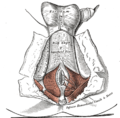This article needs additional citations for verification .(June 2017) |
| Superficial perineal pouch | |
|---|---|
 Coronal section of anterior part of male pelvis, through the pubic arch. Seen from in front. (Superficial perineal pouch is white outline at bottom.) | |
 Muscles of Male Perineum. | |
| Details | |
| Artery | Branches of internal pudendal artery |
| Vein | Branches of internal pudendal veins |
| Nerve | Branches of perineal nerve |
| Lymph | Superficial inguinal lymph nodes |
| Identifiers | |
| Latin | compartimentum superficiale perinei or spatium superficiale perinei |
| TA98 | A09.5.02.001 |
| TA2 | 2415 |
| FMA | 22062 |
| Anatomical terminology | |
The superficial perineal pouch (also superficial perineal compartment/space/sac) is a compartment of the perineum.

